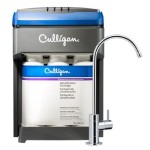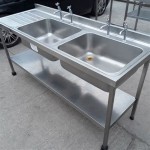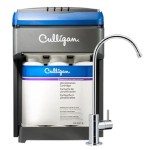Choosing the Right Kitchen Sink for Your Granite Countertop
Selecting the appropriate kitchen sink to complement a granite countertop is a pivotal decision in kitchen design and functionality. The sink not only serves a fundamental utilitarian purpose but also significantly contributes to the overall aesthetic of the space. Granite countertops, known for their durability and elegant appearance, demand a sink that can match their quality and enhance their visual appeal. A successful pairing requires careful consideration of several factors, including sink material, style, size, mounting options, and the intended use of the sink itself.
The decision-making process should also involve a thorough understanding of the granite countertop's color, pattern, and thickness. Contrasting or complementary colors can dramatically alter the kitchen's ambiance. A dark granite, for instance, might pair well with a stainless steel sink for a modern look, or a lighter-colored sink for a greater contrast and visual interest. The sink's size should be proportionate to the countertop's surface area and the size of the kitchen. Overcrowding the countertop with an excessively large sink can be visually unappealing and reduce usable workspace.
Furthermore, the mounting style of the sink plays a crucial role in both aesthetics and functionality. Undermount sinks offer a seamless transition from the countertop to the sink basin, making cleaning easier and creating a modern, minimalist look. Top-mount or drop-in sinks are easier to install and can be a practical option for those seeking a more budget-friendly solution. Farmhouse or apron-front sinks add a touch of rustic charm and can become a focal point of the kitchen. Understanding the pros and cons of each mounting style is essential for making an informed decision.
Material Matters: Sink Materials and Granite Compatibility
The material of the kitchen sink is a primary factor to consider when pairing it with a granite countertop. Several materials are commonly used for kitchen sinks, each with its own set of advantages and disadvantages. The most popular options include stainless steel, composite granite, cast iron, fireclay, and copper.
Stainless Steel: Stainless steel sinks are a perennial favorite due to their durability, affordability, and resistance to staining and corrosion. They are available in a wide range of gauges (thicknesses) and finishes, allowing homeowners to choose a sink that suits their budget and aesthetic preferences. A higher gauge number indicates a thinner steel, which may be more prone to dents and noise. Lower gauge stainless steel sinks are more durable and quieter. Stainless steel complements most granite colors and patterns, making it a versatile choice.
Composite Granite: Composite granite sinks are crafted from a blend of granite stone dust and acrylic resins. This material offers exceptional durability, heat resistance, and resistance to scratches and stains. Composite granite sinks are available in a variety of colors and textures, allowing homeowners to precisely match or complement their granite countertops. They tend to be quieter than stainless steel sinks and offer a more luxurious feel. However, they are generally more expensive than stainless steel options.
Cast Iron: Cast iron sinks are coated with a porcelain enamel finish, which provides a durable and attractive surface. They are known for their heat resistance and ability to retain heat, making them ideal for washing dishes. Cast iron sinks are available in a range of colors, but white is the most common option. While durable, the porcelain enamel can chip or scratch over time, requiring careful maintenance. Cast iron sinks are typically heavier than other types, requiring a robust countertop support structure.
Fireclay: Fireclay sinks are made from a type of ceramic clay fired at extremely high temperatures. This process creates a dense and durable material that is resistant to scratches, stains, and chipping. Fireclay sinks are often used in farmhouse-style kitchens due to their classic and elegant appearance. They are available in a variety of colors and sizes, but white is the most common choice. Fireclay sinks can be prone to cracking if subjected to sudden temperature changes or impacts, so careful handling is crucial.
Copper: Copper sinks offer a unique and distinctive look that can add warmth and character to any kitchen. Copper is naturally antimicrobial and resistant to corrosion. Over time, copper sinks develop a patina, which is a natural darkening and color variation that adds to their charm. Copper sinks can be more expensive than other options and require special care to prevent staining and discoloration. It is important to choose a copper sink made from a high-quality gauge of copper to ensure durability.
Sink Style and Configuration: Functionality Meets Design
The style and configuration of the kitchen sink also play a critical role in its overall functionality and aesthetic appeal. The most common sink styles include single-bowl, double-bowl, and triple-bowl sinks. Each style offers different advantages depending on the user's needs and preferences.
Single-Bowl Sinks: Single-bowl sinks offer a large, unobstructed basin, making them ideal for washing large pots, pans, and baking sheets. This style is particularly well-suited for smaller kitchens where space is limited. Single-bowl sinks are generally less expensive than multi-bowl sinks and offer a cleaner, more minimalist look. However, they may not be as convenient for multitasking, such as washing dishes in one basin and rinsing them in another.
Double-Bowl Sinks: Double-bowl sinks feature two separate basins, allowing for greater versatility in dishwashing and food preparation. One basin can be used for washing dishes, while the other can be used for rinsing or soaking. Double-bowl sinks are a popular choice for larger kitchens and households with multiple cooks. The basins can be of equal size or different sizes, depending on the user's preferences. A 50/50 split offers equal space for each task, while a 60/40 split provides more space in one basin than the other. The lower divider between the sink bowls can make it challenging to wash larger items.
Triple-Bowl Sinks: Triple-bowl sinks offer the ultimate in versatility, with three separate basins for washing, rinsing, and drying dishes. These sinks are typically larger than single-bowl or double-bowl sinks and are best suited for larger kitchens with ample countertop space. Triple-bowl sinks can be particularly useful for households that do a lot of cooking and entertaining. However, they can be more expensive and require more maintenance than other sink styles.
In addition to the number of bowls, the shape and depth of the sink are also important considerations. Deeper sinks offer more space for washing large items and can help to prevent splashing. Rectangular sinks are a classic and versatile choice, while round or oval sinks can add a touch of visual interest. The choice of sink style and configuration will ultimately depend on the individual user's needs and preferences.
Mounting Options: Undermount, Top-Mount, and Farmhouse
The mounting style of the kitchen sink significantly impacts both the aesthetics and functionality of the kitchen. The three primary mounting options are undermount, top-mount (also known as drop-in), and farmhouse (also known as apron-front).
Undermount Sinks: Undermount sinks are installed beneath the countertop, creating a seamless transition from the countertop to the sink basin. This mounting style offers a clean, modern look and makes it easy to wipe crumbs and spills directly into the sink. Undermount sinks require a precise cutout in the countertop and professional installation. They are typically more expensive than top-mount sinks. Undermount sinks are particularly well-suited for granite countertops, as they highlight the natural beauty of the stone and create a sleek, contemporary aesthetic.
Top-Mount (Drop-In) Sinks: Top-mount sinks are installed by dropping them into a pre-cut hole in the countertop. The sink's rim rests on the countertop, providing a secure and stable installation. Top-mount sinks are generally easier and less expensive to install than undermount sinks. This mounting style is a practical option for DIY projects and budget-conscious homeowners. However, the rim of the sink can trap crumbs and spills, making it more difficult to clean. Top-mount sinks are a versatile choice that can complement a variety of kitchen styles.
Farmhouse (Apron-Front) Sinks: Farmhouse sinks feature a large, exposed front that extends beyond the edge of the countertop. This style adds a touch of rustic charm and can become a focal point of the kitchen. Farmhouse sinks require a special cabinet base to support their weight and unique design. They are typically more expensive to install than undermount or top-mount sinks. Farmhouse sinks are available in a variety of materials, including fireclay, stainless steel, and copper. The apron front is typically exposed, making it a prominent design element within the kitchen. They can be a very heavy choice and require additional bracing in the cabinets.
Choosing the right kitchen sink for a granite countertop requires careful consideration of material, style, configuration, and mounting options. By carefully evaluating these factors, homeowners can select a sink that not only meets their functional needs but also enhances the overall beauty and value of their kitchen.

Granite Countertops Undermount Sinks A Perfect Pair

How To Choose A Kitchen Sink For Granite Countertops Selection

Sink Options For Granite Countertops Bathroom Kitchen Sinks C D Minneapolis Minnesota

Kitchen Design Ideas

Kitchen Sink Options Cabinet Countertop Inspirations

Kitchen Sink And Granite Countertop Ideas

How To Choose Your Kitchen Sink Granite Busters

5 Best Kitchen Sinks That Work Well With A Granite Countertop Pellak Construction

How To Choose A Kitchen Sink For Granite Countertops Selection

How To Choose A Sink For Granite Countertops Transformations







